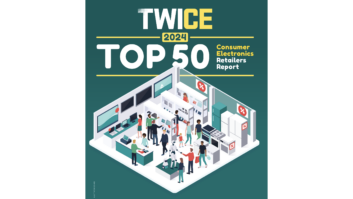
For over two decades, top executives from the consumer tech retailing and distributing industry have gathered on the first day of CES to share their perspective on holiday results and the year ahead. Top-of-mind topics for this year included smart appliances, 5G, hiring challenges and the potential impact of tariffs.
Read on for an edited version of the conversation.
TWICE: Steve, start us out by letting us know some of the top products from the holiday selling season.
Stephen Baker, tech industry analyst, The NPD Group: We saw about 3 percent growth over the holiday, which was better on an overall basis, and which over the entire year was a little under 3 percent.
Holidays started out gangbusters. The first three weeks in November were a little better than normal, mostly due to new products from Apple, such as MacBook Airs and the iPad Pro. Black Friday, Thanksgiving week and Cyber Week sales were up 5 percent over the previous year and the best in the past four or five years at least.
The last four weeks were basically flat, which resulted in that 3 percent number.
See also: Was 2018 The End Of Black Friday As We Know It?
Product highlights reveal it’s a TV world. For the holiday, TVs are traditionally about 20 percent of revenue and remained so, but the mix was heavily weighted toward big screens. Pricing was really aggressive this year, with the average price being $356 — the lowest seen in seven or eight years.
The average price of a 65-inch TV in 2017 was $1,150, and this year it was $830, which drove high volume of … units of 65-inch TVs, making it one of the big winners.
Other big winners included Chromebooks, especially during Thanksgiving week, and AirPods, which were unbelievably strong with sales three times over what they were over the previous year.
TWICE: AirPods or True Wireless?
Baker: AirPods are probably 85 percent, 90 percent of that category. There are a lot of things going on outside of that. We saw really good results for over-the-ear headphones, from Bose and Sony, at the $250 price point. Unexpectedly, there were more entry-level sales than expected.
See also: The Outlook For True Wireless
Some of the better products, such as the Sonos Beam Sound Bar and some Bose products, did very well because they were priced a lot lower.
Perhaps most surprising is the real strength during Thanksgiving week and Cyber Week was the retailer websites. Retail online has been gaining share in buckets against the competitors in that setting. Online retail has higher shares of higher price point products during the holiday than for online-only websites.
One of the big lessons for 2018 is that brick-and-mortar retail has learned how to create a blended retail environment and are taking advantage of it. Consumers are more willing to shop around. They’re able to leverage the fact that if they spend a lot of money on consumer electronics, they want to see it and have an experience with it before they buy it, but are also willing to do a lot of online research. However, when it comes to purchases, there is not a material advantage to buying from an online retailer vs. buying from a retailer.
Trevor May, executive director, vendor management, D&H Distributing: It’s nice to see that balance out after so many years coming in here. It’s been dot-com and e-commerce growth, and the “death of retail” brick-and-mortar stores closing.
Baker: We know this to be true. The word always has been that Amazon has half the tech online revenue, but when you get to 50 percent market share, it’s hard to keep growing. A 50 percent to 55 percent share gain is much harder than a 5 percent to 10 percent share gain. It is a combination of large numbers and the rest of retail catching up that creates a ceiling on things some of the online retailers could do.
Michael D. McMahon, national retail, direct2consumer & distribution strategy, Sprint: Sprint is seeing the same trend. I think it is integration of brick-and-mortar and digital. This year there was a massive movement of customers buying online and picking up in store, so we also introduced buy online and pick up at Walgreens because it is a FedEx location. Those two things have had exponential growth since last year. We’re looking at that as the new normal.
Baker: There is still a lot of work to be done with buy-online/pick-up in-store because the big share gains seen are mostly in higher price points. Retailers don’t want to do a lot with low-cost cellphone cases and Bluetooth speakers due to the high cost of shipping, etc. They’re trying to balance where they should be competitive and where they shouldn’t. Buy online and pick-up in-store works well for high prices.
Stephanie Keough, chief merchant, World Wide Stereo: We have buy online/pick-up in-store. We see success because it guarantees a higher-priced item is there when you get there. It’s purchased, so it’s there and you’re not wasting your time. It’s also the customer service experience when you get there because it is a higher-price ticket and that integration of the product is what so many people are looking for as well.
Debbie Schaeffer, principal, Mrs. G TV & Appliances: We’re a single community-based appliance store in New Jersey. We sell TVs, but mostly appliances, delivering to New Jersey, Pennsylvania and New York. You’re right that there has to be integration. We’re a member of Nationwide, which gives us the tools to afford that integration. However, the phones don’t stop ringing. Customers with more questions come to the store, but customers who know exactly what they want don’t want to come in and [instead] buy it over the phone.
See also: Mrs. G Still Blooming In The Garden State
We really focus on the holiday sales. Black Friday is the entire month of November, probably starting Nov. 10. Customers in 2018 and 2017 who could wait to purchase a washer and dryer, dishwasher or a four-piece set purchased during the holiday weekend because the LG, Samsung and Whirlpool price swings [were] ridiculous.
Sales were good, but it was challenging because margins were hard due to special price points. We were up 10 percent from 2017. Luxury appliances were up significantly, while core appliances were on the flat side in November/December.
May: Welcome to the appliance world turning into the CE world with price compression and margin compression.
See Part II: Are Consumers Ready For Connected Home? All Signs Point To … Almost













